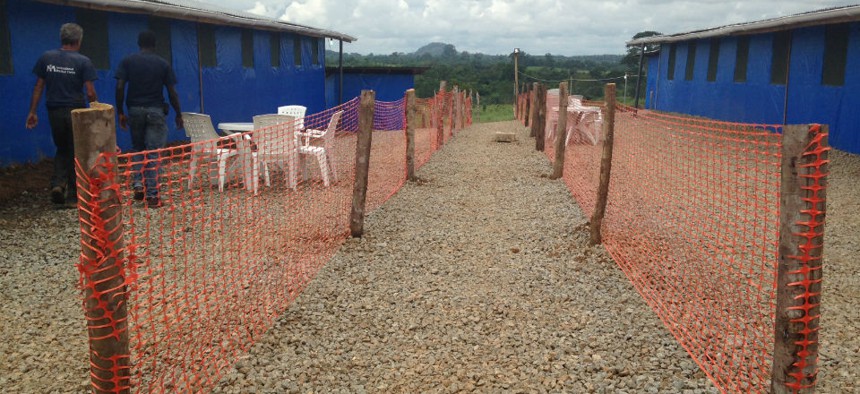
An Ebola treatment facility in Liberia. CDC Global
This Is How Much the U.S. Has Accomplished in Ebola Preparedness in Only Two Months
The nation may have reached peak preparedness for any possible future domestic cases.
There are no reported Ebola cases in the United States right now. But should one emerge, the country is more than prepared to handle it.
The White House released on Tuesday a comprehensive review of how the domestic and international response to the deadly virus both has changed in the past two months, when a patient was diagnosed with Ebola on American soil for the first time in history. The level of preparedness, described in more than 5,700 words, is massive, and something that countries such as Liberia, New Guinea, and Sierra Leone, which are at the center of the Ebola outbreak, can only dream of. The update comes ahead of President Obama's visit to the National Institutes of Health in Bethesda, Md., on Tuesday night, where he's expected to ask Congress to grant his request for $6.2 billion in emergency funds for Ebola response efforts worldwide.
Here are the highlights of the administration's update:
There's a greater U.S. presence on the ground in West Africa. The number of military personnel has risen from several hundred in the summer to 3,000 this month. U.S. workers have the capacity to train 200 health care workers per week in Monrovia, the capital of Liberia. And the number of U.S.-supported burial teams has risen from 12 in September to 65 in December. The teams are called to dispose of bodies of deceased Ebola patients, who are most contagious after death, to minimize the risk of exposure to others.
And the U.S. personnel have constructed new medical facilities there. The U.S. military opened three treatment units this month. Seven more are expected to be up and running in a few weeks.
More U.S. hospitals are ready for Ebola patients. Before Ebola arrived in the United States, federal health officials didn't know how to judge whether a hospital was prepared to treat the disease. The U.S. had just eight hospital beds in three facilities with the "biocontainment capability" necessary to treat highly infectious diseases such as Ebola. Now, 53 beds at 35 designated treatment centers are available, from coast to coast.
Obama's "Ebola SWAT Team" exists. In mid-October, the president directed the Centers for Disease Control and Prevention to build a team that could travel to U.S. hospitals with Ebola cases within 24 hours of a diagnosis. The group has since visited 52 facilities in 15 states and Washington, D.C., to advise health workers on treatment, containment, and protocol for personal protective gear.
More laboratories can now test for the virus. Before the outbreak in West Africa, Ebola could be confirmed only at CDC headquarters in Atlanta. By August, 13 labs in 13 states had the capacity to test for Ebola. Now, 42 labs in 36 states can do so, with authorization from the Food and Drug Administration, which has approved six different diagnostic tests. And doctors can get results much faster. An Ebola specimen tested at Mt. Sinai Hospital in New York City in August took 24 hours to complete. Now, it takes just four to six hours. One of the FDA-approved tests produces results in less than an hour.
An Ebola vaccine has made it through the first set of clinical trials. The vaccine, developed by the National Institute of Allergy and Infectious Diseases and British pharmaceutical company GlaxoSmithKline, has shown promise in preliminary trials. Four others are in development, and health officials expect to begin clinical trials in West Africa in the coming weeks.
The feds check with people who recently returned to the U.S. from Ebola-affect countries every day. Those people, who, since October, are allowed to enter the U.S. only through five specific airports, are required to report their temperature readings twice a day to state public health officials for 21 days, the accepted incubation period for Ebola. The White House reports that more than 80 percent of travelers returning from West Africa live within 200 miles of a treatment center.
Federal health officials have talked to thousands of health workers about Ebola. Employees at the CDC and the Health and Human Services Department have held more than 100 conference calls and 30 webinars about infection control and protective gear. They have regularly called 20,000 physicians and dentists and 10,000 nurses.







